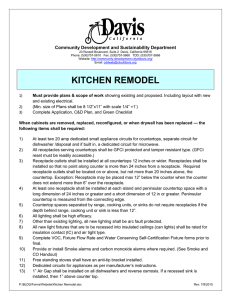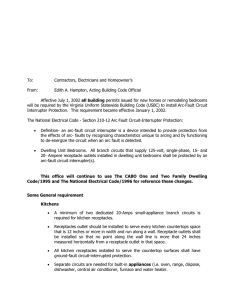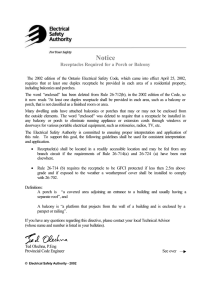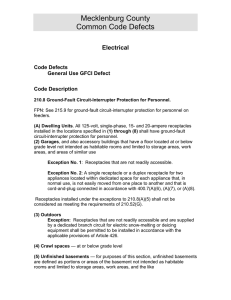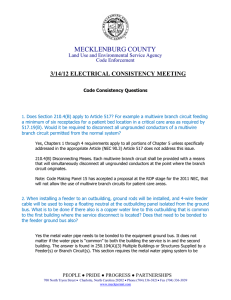Residential Wiring Guide
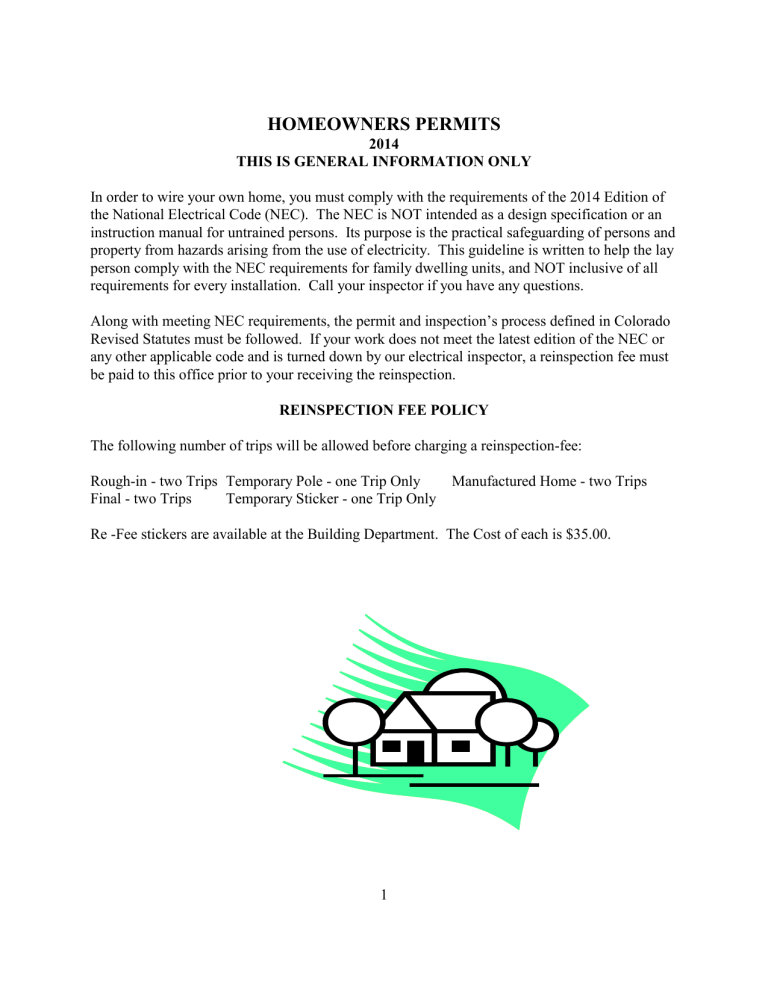
HOMEOWNERS PERMITS
2014
THIS IS GENERAL INFORMATION ONLY
In order to wire your own home, you must comply with the requirements of the 2014 Edition of the National Electrical Code (NEC). The NEC is NOT intended as a design specification or an instruction manual for untrained persons. Its purpose is the practical safeguarding of persons and property from hazards arising from the use of electricity. This guideline is written to help the lay person comply with the NEC requirements for family dwelling units, and NOT inclusive of all requirements for every installation. Call your inspector if you have any questions.
Along with meeting NEC requirements, the permit and inspection’s process defined in Colorado
Revised Statutes must be followed. If your work does not meet the latest edition of the NEC or any other applicable code and is turned down by our electrical inspector, a reinspection fee must be paid to this office prior to your receiving the reinspection.
REINSPECTION FEE POLICY
The following number of trips will be allowed before charging a reinspection-fee:
Rough-in - two Trips Temporary Pole - one Trip Only Manufactured Home - two Trips
Final - two Trips Temporary Sticker - one Trip Only
Re -Fee stickers are available at the Building Department. The Cost of each is $35.00.
1
1.
GUIDELINES FOR WIRING SINGLE FAMILY DWELLING UNITS
SERVICE
COPPER
AWG
4
3
2
1
ALUMINUM AND COPPER
CLAD AL - AWG
2
1
1/0
2/0
SERVICE RATING
IN AMPS
100
110
125
150
The service equipment must be large enough to supply the connected load which is calculated using Article 220 of the NEC. The most common sizes of residential service equipment are
100,125, 150, 175 and 200 amperes. The minimum size wires for service entrance conductors are listed below:
THREE WIRE, SINGLE PHASE DWELLING SERVICES
Conductor Types and Sizes
RH-RHH-RHW-THHW-THW-THWN-THHN-XHHW-USE
1/0
2/0
3/0
4/0
175
200
3/0
4/0
250 kcmil
350 kcmil
400 kcmil
250 kcmil
300 kcmil
350 kcmil
500 kcmil
600 kcmil
225
250
300
350
400
Use an aluminum anti-oxidant on all aluminum connections.
Wire that is to be buried must be suitable for underground, example U.S.E.
The service equipment must be grounded in accordance with Article 250 of the NEC, which in general, says that the neutral must be marked white or gray and must be bonded to the service enclosure and the grounding electrode system defined in 250.1 NEC. The nipple between the meter and the panel, if metal, must be grounded or bonded to the neutral and ground bar that are
2
tied together. The main service equipment panel will be mounted either outside or inside the dwelling as near as possible to the point of entrance of the service conductors to the building.
Grand Valley Rural Power requires an outside disconnect. All service equipment and electrical panels must have a clear area 30 inches wide, and 36 inches deep in front. This clear area must extend from floor to ceiling with no intrusions from other equipment cabinets, counters, appliances, etc. The bond screw must be green in color. The main service equipment, the neutral and equipment grounding conductors are bonded together. In sub panels, the neutral is isolated from the ground. A water bond and service raceway nipple, if metal, must be bonded also and should be #6 copper for 100 amp and #4 copper for 200 amp.
NOTE: The neutral shall be bonded only at the first point of service and an equipment grounding conductor shall be installed on all branch circuits and feeders.
New construction will require a concrete encases electrode consisting of not less than 20 feet of
½ inch rebar or #4 or larger bare copper wire. This electrode must be encased in at least 2 inches of concrete located within and near the bottom of the footer or foundation which ever is lower.
In addition to this Mesa County will still require the ground rod.
2. BRANCH CIRCUIT WIRING
Type NM cable (a.k.a. romex) is the most widely used wiring method in residential dwellings.
NM cable must have 90 degree conductor insulation rating, which is designated on the cable sheath by the letter “B,” Type N.M. - B. #12 and #14 is used for lighting and receptacle circuits, while #10/2 is used for electric water heaters, #10/3 for electric dryers, cook-tops need #8/3 and
#6/3 for ranges and mounted wall ovens. Ranges and clothes dryers must be wired with four wires. Four conductor cables and receptacles must be used. These cables must be protected by over-current devices (circuit breakers) which do not exceed the rated amp capacities for cable types as listed below: [all cables must include an equipment grounding conductor].
COPPER NM CABLE
15 amperes for #14
TYPE S.E.R. ALUMINUM CABLE
30 amperes for #8
20 amperes for #12
30 amperes for #10
40 amperes for #8
60 amperes for #6
70 amperes for #4 copper
40 amperes for #6
60 amperes for #4
70 amperes for #3
80 amperes for #2
Use aluminum anti-oxidant on all aluminum connections.
It is important to note that if you begin a circuit with #12, you must use this same wire size throughout, you CANNOT mix different wire sizes on the same branch circuit.
Type NM cable must be stapled within 12 inches of metal boxes, 8 inches of plastic boxes and every 4 ½ feet thereafter. Proper connectors must be used where NM cable enters metal cabinets, boxes or panel boards.
3
When Type NM cable is installed to framing members, it shall be located at least 1 1/4 inches from the nearest edge of the framing member where nails or screws may penetrate the cable. If this distance cannot be maintained, the cable shall be protected by a steel plate or sleeve at least
1/16 inch thick.
A ceiling mounted paddle fans weighing 35 pounds or less must be supported by outlet boxes identified for such use. Boxes for this use must be of the UL listed “Fan” Approved type.
3. REQUIRED BRANCH CIRCUITS
A. Small Appliance Branch Circuits - The NEC requires a minimum of two 20 ampere branch circuits to feed receptacle outlets for small appliance loads, including refrigeration equipment in the kitchen, pantry, breakfast room, and dining room. These circuits, whether two or more shall NOT feed anything other than receptacles in these areas. Only six outlets are allowed on each circuit. Lighting outlets and built-in appliances such as garbage disposal, range hoods, microwave, dishwashers, and trash compactors are NOT permitted on these circuits.
Counter top receptacles shall not be used for general wall space requirements.
B. Laundry Branch Circuit - One 20-amp branch circuit must be provided for the laundry.
This circuit is limited to receptacles within the laundry room. No other outlets or lights are permitted on this circuit.
C. General lighting branch circuits may be wired in #14 on a 15-ampere breaker with 10 devices per circuit, 20 amp branch circuit using #12 wire are allowed 12 devices. These lights and receptacle outlets, are other than those covered in A and B above.
D. Heating system shall have a separate circuit.
4. REQUIRED RECEPTACLE OUTLETS
A. One bathroom receptacle adjacent and within 3 feet of each basin. All bathroom receptacles shall meet the requirements of #1 or #2 below.
1.) The basin receptacle is required to be a 20-amp branch circuit with no other plugs,
except other bathroom receptacles.
2.) A bathroom may be all on a single circuit by itself lights, exhaust fan,and receptacles
provided that everything in that bathroom is on the required 20-amp branch circuit.
B. At least one receptacle in every attached or detached garage and accessory building with
4
electric power. Install one receptacle for each car space, the branch circuits that supply these receptacles shall not supply outlets outside of the garage.
C. One receptacle installed outdoors at the back and front of dwellings. Both receptacles shall be accessible at grade level and not more than 6 ½ feet above grade.
D. At least one receptacle shall be installed within the perimeter of a balcony, porch, or deck that is accessible from inside the dwelling.
E. At least on receptacle must be installed in each unfinished area of a basement. This receptacle is in addition to any that may be installed for laundry and finished areas or other specific purposes.
F. In every family room, dining room, living room, parlor, library, den, sun room, bedroom, recreation room, or similar room or area of dwelling units, receptacle outlets shall be installed so that no point along the floor line in any wall space is more than six feet measured from an outlet in that space, including any wall space, two feet or more in width, and excluding only that space afforded by fixed dividers, such as freestanding bar-type counters, shall be included in the sixfoot measurement. No outlet may be installed over an electric baseboard heater.
G. In kitchens and dining rooms, a receptacle outlet shall be installed to serve each counter space wider than 12 inches. Receptacles shall be installed so that no point along the wall line is more that 24 inches measured horizontally from a receptacle outlet in that space. Islands 12 inches or wider shall have at least one receptacle. Required receptacles shall not be inside of an appliance garage.
H. Receptacles installed in the floor must be a box / receptacle combination designed specifically for that purpose. Receptacles installed in the floor within 18 inches of the walls may be used in place of the wall mounted receptacles.
I. length.
A receptacle outlet is required in any dwelling unit hallway that is ten feet or more in
J. Garbage disposal, dishwashers, trash compactors and large microwaves need to be on a separate circuit.
5. REQUIRED LIGHTING OUTLETS
A. At least one wall switch-controlled lighting outlet or light shall be installed in every habitable room: bathroom, hallways, stairways, attached garages, detached garages with electric power, and at outdoor entrances and exits. The lighting outlet for interior stairways shall have a wall switch at each floor level where the difference between floor levels is six steps or more.
B. At least one wall switch controlled light shall be installed in an attic, under floor space, utility room and basement, where these spaces are used for storage or contain equipment
5
requiring servicing. The switch shall be located at the point of entry to these areas and provide illumination to all equipment.
C. All light fixtures and lamps must be (UL) approved for their location and use.
D. A grounded (neutral) conductor shall be installed in the switch location providing power to a lighting load.
6. GROUND FAULT PROTECTION
All receptacles listed below must be protected by a ground fault circuit interrupter. All ground fault circuit interrupter devices must be located in a readily accessible location. a. Sheds b. Garage and accessory buildings c. All receptacles in an unfinished basement or crawl space at or below grade d. Bathroom receptacles e. All outdoor receptacles f. Kitchen receptacles that serve counter tops g. All temporary construction power h. Laundry areas.
I. Where the receptacles are within 6 feet of the outside edge of a sink,bathtub,or
shower stall.
7.
J. Kitchen dishwasher.
NOTE: 15 and 20 amp 125 and 250 volt receptacles in wet locations shall have in- use covers and damp or wet location receptacles shall be listed weather resistant.
CONDUCTOR FILL
Outlet and junction boxes shall be of sufficient size to provide free space for all conductors and devices enclosed in the box. All outlet boxes have a specific volume, measured in cubic inches.
(See Table 314.16 (A) and 314.16 (B)).
Conductor, Device or Type of Fitting
----------------------------------------------------------------------------------------------------------------------
Each conductor originating outside and terminating or spliced inside box---------------------1
Each conductor passing through unbroken----------------------------------------------------------1
Conductors that do not leave box---------------------------------------------------------------------0
Not more than four, #. 16 or smaller fixture wires plus ground from a canopy----------------0
Internal cable clamps (per type)-----------------------------------------------------------------------1
Support Fittings (fixture studs or hickeys (per type)-----------------------------------------------1
A device or equipment yoke (e.g., switch, receptacles)----------------------------- --------------2
Equipment grounding conductors (all)---------------------------------------------------------------1
Addnl. Equip. Grounding conductors(s)-------------------------------------------------------------1
6
No allowance is required for small fittings like locknuts and bushings.
Refer to following charts for sizing boxes.
Volume Required per Conductor
Size of a conductor Free Space within Box for
Each Conductor
No. 18 ................................................................................................ 1.5 Cubic Inches
No. 16 ................................................................................................ 1.75 Cubic Inches
No. 14 ................................................................................................ 2.0 Cubic Inches
No. 12 ................................................................................................ 2.25 Cubic Inches
No. 10 ................................................................................................ 2.5 Cubic Inches
No. 8 ................................................................................................ 3.0 Cubic Inches
No. 6 ................................................................................................ 5.0 Cubic Inches
8. SMOKE DETECTORS
SINGLE AND MULTIPLE STATION SMOKE ALARMS. Single and multiple-station smoke alarms shall be installed in the following locations:
1. In each sleeping rooms.
2. Outside of each separate sleeping area in the immediate vicinity of the bedrooms.
3. On each additional story of the dwelling, including basements and cellars but not
Including crawl space and uninhabitable attics. In dwellings or dwelling units with split levels and without an intervening door between the adjacent levels , a smoke alarm installed on the upper level shall suffice for adjacent lower level provided that the lower level is less than one full story below the upper level.
When more than one smoke alarm is required to be installed within an individual dwelling unit the alarm devices shall be interconnected in such a manner that the actuation of one alarm will activate all of the alarms in the individual unit. The alarm shall be clearly audible in all bedrooms over background noise levels with all intervening doors closed.
All smoke alarms shall be listed and installed in accordance with the provisions of this code and the household fire warning equipment provisions of NFPA 72.
ALTERATIONS, REPAIRS AND ADDITIONS. When interior alterations, repairs or additions requiring a permit occur, or when one or more sleeping rooms are added or created in existing dwellings, the individual dwelling unit shall be equipped with smoke alarms located as required for new dwellings; the smoke alarms shall be interconnected and hard wired.
7
EXCEPTIONS:
1. Smoke alarms in existing areas shall not be required to be interconnected and hard wired where alterations or repairs do not result in the removal of interior walls or ceiling finishes exposing the structure, unless there is an attic, crawl space, or basement available which could provide access for hard wiring and interconnection without the removal of interior finishes.
2. Work involving the exterior surfaces of dwellings, such as the replacement of roofing
or siding, or the addition or replacement of windows or doors, or the addition of a porch
or deck, are exempt from the requirements of this section.
POWER SOURCE. In new construction, the required smoke alarms shall receive their primary power from the building wiring when such wiring is served from a commercial source, and when primary power is interrupted, shall receive power from a battery. Wiring shall be permanent and without a disconnecting switch other than those required for over current protection. Smoke alarms shall be permitted to be battery operated when installed in buildings without commercial power or in buildings that undergo alterations, repairs or additions regulated by Section
R317.1.1.
Colorado State Law and the 2012 IRC requires carbon monoxide alarms.
For new construction, an approved carbon monoxide alarm shall be installed outside of each separate sleeping area in the immediate vicinity of the bedrooms in dwelling units within which fuel-fired appliances are installed & in dwelling units that have attached garages.
Where work requiring a permit occurs in an existing dwelling that have attached garages or in existing dwelling which fuel-fired appliances exist, carbon monoxide alarms shall be provided in the above locations.
Carbon monoxide alarms shall be listed and installed in accordance with the 2012 IRC and the manufacture’s installation instructions.
EQUIPMENT GROUNDING CONDUCTOR MAKE UP
All equipment grounding conductors must be connected together with solder-less pressure connectors such as wire nuts or crimp sleeves, leaving sufficient extra conductor for attachment to the metal box and/or devices. Please note that ALL metal junction and outlet boxes must be grounded by attaching the equipment grounding conductor out of the NM cable to the metal box using an approved green screw or grounding clip. Sheet metal screws are not allowed.
10. ELECTRIC HEAT CIRCUITRY
Electric heat may be installed on 15, 20, or 30 amp branch circuits. Listed below is the maximum wattage that may be installed on each size branch circuit. All circuits are figured at
240 volts.
8
Maximum
Maximum
Maximum
15A - 2,880 Watts
20A - 3,840 Watts
30A - 5,760 Watts
11. DETACHED GARAGES OR OUT BUILDINGS
If there is only one circuit, a snap switch may be used as a disconnect.
For two or more circuits, a panel is needed with the minimum of a 60-amp service. For more than
6 breakers a main will be required. A breaker of the same amperage will go in the “house” panel
- two hot wires, a neutral and ground are run to the out building where a panel with main breaker and ground rod are placed. The circuits for the garage will come out of this panel.
The garage must have a light inside and a light outside of each “man” door and a 110 volt receptacle. All receptacles must be at least 18 inches from the bottom of the box to the floor.
12. ROUGH-IN INSPECTION
At the time you call for your rough-in inspection, you must have all wire pulled, stapled and all splices made up and ready to accept devices and fixtures. Please DO NOT install any devices or fixtures or cover wiring with insulation or wall cover, i.e., drywall or paneling. All wires must extend at least six (6) inches past the front of the box.
13. TEMPORARY SERVICE
You may call for a temporary service inspection when the following items are complete:
Your panel and meter housing are installed and wired, the ground rod is driven in place and hooked up, a GFCI receptacle is installed and a 20 amp breaker installed on the laundry circuit.
The department will inspect the service, if approved a green tag will be issued. After approval is given the power supplier may be called and service will be allowed prior to your final electrical inspection. Conductors and cables exposed to direct rays of the sun shall be listed or marked
“Sunlight Resistant”.
14. UNDERGROUND
Wire that is to be installed underground must be inspected before it is covered.
15. UNDERGROUND SERVICE LATERALS
All service laterals must be inspected before they are covered.
Laterals that are not encased in concrete or installed in an approved race way will require 2 inspections.
1) When conductors are in bottom of a 24 inch minimum trench.
2) After12 inches of back fill and a warning ribbon is installed over the cable.
9
16. FINAL INSPECTIONS
The electrical installation should be complete at the time of request. All devices and fixtures installed service equipment complete and labeled properly. All wiring shall be free from shorts, ground faults and open circuits. All light fixtures are required to be grounded along with light switches and receptacles.
AG BUILDINGS
Please pay attention to Article National Electrical Code #547 for electrical requirements, before building or pouring any concrete.
18.
ARC FAULT CIRCUIT INTERRUPTER
All 120-volt, single phase, 15 and 20-ampere branch circuits supplying outlets installed in dwelling units except bathrooms and garages shall be protected by a listed arc-fault circuit interrupter combination type. When an existing branch circuit is modified, replaced or expanded
AFCI’s shall be installed. All AFCI devices shall be located in a readily accessible location.
19. TAMPER-RESISTANT RECEPTACLES
All 15- and 20-ampere receptacles in a dwelling unit shall be listed tamper-resistant.
20. BONDING FOR OTHER SYSTEMS
A ground bar or set of terminals that has space for 3 or more wires shall be mounted on or at each building service and shall be external to the enclosure.
Homeowners2011
10
